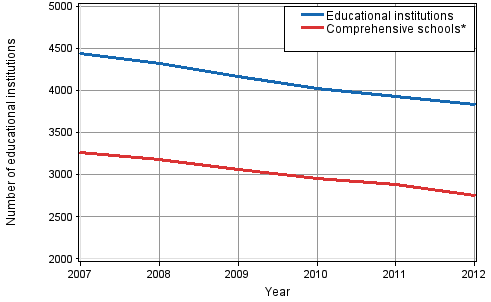Published: 19 February 2013
Number of comprehensive schools 81 lower than one year before, highest number of closures in the Region of Uusimaa
According to Statistics Finland's Register of Providers of Education and Register of Educational Institutions, there were 783 active providers of education and 3,838 educational institutions in which 1.92 million students pursued studies at the end of 2012. The number of all educational institutions has fallen by 14 per cent in five years. In 2007, the number of comprehensive schools was nearly 3,300, whereas at the end of 2012 their number was only just under 2,800.
Number of all educational institutions and comprehensive schools in 2007–2012

*Comprehensive schools include types 11,12,19 of educational institutions.
The number of providers of education was 3 lower than in 2011. Of the providers of education 47 per cent were municipalities or joint municipal boards, seven per cent were central government units and 44 per cent private. The remaining two per cent of the providers of education operated in the region of ┼land. In 2012, there were 3 new providers of education to be added to the Register of Providers of Education. The number of educational institutions was 96 lower than the year before.
Educational institutions of the school system and numbers of students by type of educational institution in 2012
| Type of educational institution | Number | Change from previous year 1) | Students 2) |
| 11 Comprehensive schools 3) | 2 644 | -73 | 520 000 |
| 12 Comprehensive school level special education schools | 110 | -8 | 5 600 |
| 15 Upper secondary general schools | 381 | -7 | 118 000 |
| 19 Comprehensive and upper secondary general level schools 3) | 41 | - | 26 600 |
| 21 Vocational institutes | 124 | -5 | 176 200 |
| 22 Special needs vocational institutes | 6 | - | 5 200 |
| 23 Specialised vocational institutes | 34 | 0 | 28 600 |
| 24 Vocational adult education centres | 26 | - | 36 700 |
| 28 Fire, police and security service institutes | 1 | - | 300 |
| 29 Military vocational institutes | 13 | - | .. |
| 41 Polytechnics | 27 | - | 147 700 |
| 42 Universities | 16 | - | 168 200 |
| 43 Military academies | 1 | - | 800 |
| 61 Music schools and colleges | 88 | - | 66 700 |
| 62 Sports institutes | 14 | - | 4 600 |
| 63 Folk high schools | 80 | -2 | 20 700 |
| 64 Adult education centres | 195 | -1 | 526 700 |
| 65 Study circle centres | 10 | - | 33 700 |
| 66 Summer universities | 20 | - | 34 900 |
| 99 Other educational institutions | 7 | - | 600 |
| Total | 3 838 | -96 | 1 921 800 |
2) The data on the number of students are mainly as on 20 September 2012 and include the number of all students in educational institutions belonging to the type of educational institution independent of the level of education.
3) The type of educational institutions for two educational institutions was changed from type 11 to type 19.
There were 2,644 active comprehensive schools which had 520,000 pupils. Special education schools at the comprehensive school level numbered 110 and they had 5,600 pupils. A total of 80 comprehensive schools or comprehensive school level special education schools were closed down or merged with another educational institution. Of these, 12 were educational institutions with under 20 pupils, 33 had between 20 and 49 pupils while 35 had at least 50 pupils. The number of closures was the highest in the region of Uusimaa.
Of all comprehensive schools 74 per cent taught grades 1 to 6, 13 per cent taught grades 7 to 9 and 13 per cent of comprehensive schools taught grades from 1 through to 9. In all, 24 per cent of comprehensive schools had under 50 pupils and six per cent had over 500 pupils.
Source: Education Statistics. Statistics Finland
Inquiries: Mika Witting 09 1734 3571, koulutustilastot@stat.fi
Director in charge: Riitta Harala
Publication in pdf-format (237.3 kB)
Updated 19.2.2013
Official Statistics of Finland (OSF):
Providers of education and educational institutions [e-publication].
ISSN=1799-5825. 2012. Helsinki: Statistics Finland [referred: 22.12.2025].
Access method: http://stat.fi/til/kjarj/2012/kjarj_2012_2013-02-19_tie_001_en.html

